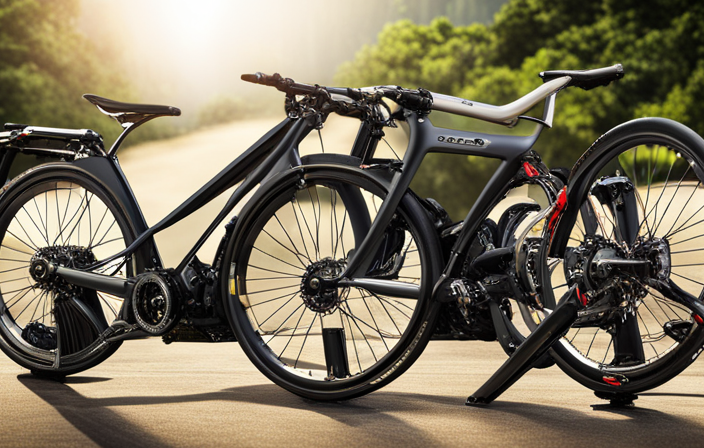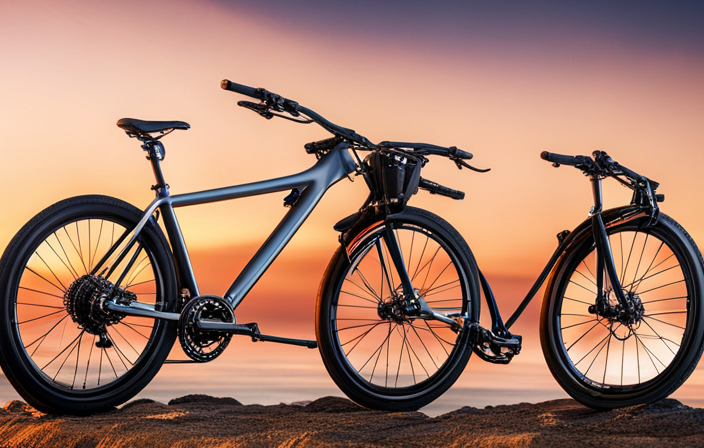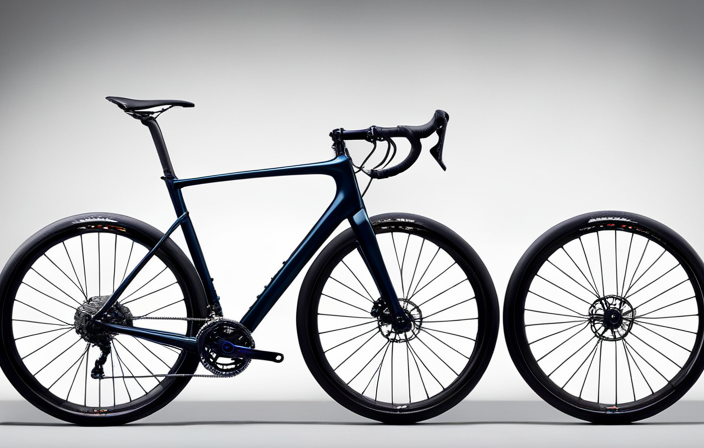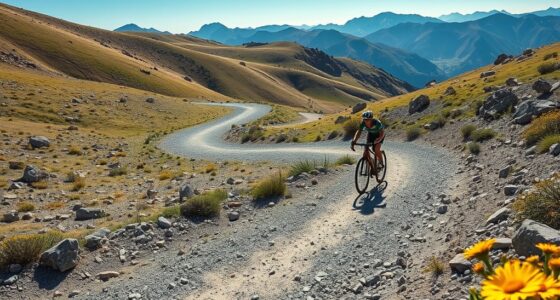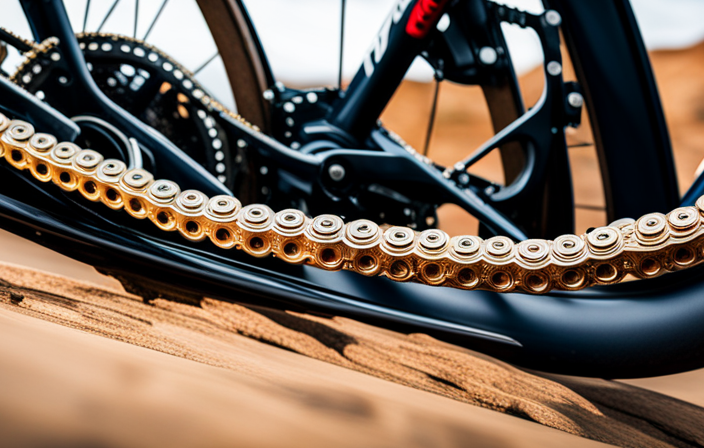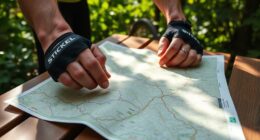While riding my gravel bike through the rough terrain, I realize the importance of brakes. They serve as a crucial element in maintaining the balance between control and excitement when tackling unpredictable surfaces.
In this article, we delve deep into the world of gravel bike brakes, exploring disc brakes, hydraulic systems, mechanical options, and more.
Join me as we uncover the technical nuances and considerations that will ensure your ride remains safe and thrilling.
Key Takeaways
- Disc brakes are commonly used on gravel bikes due to their superior stopping power and reliability.
- Hydraulic brakes are preferred for gravel bikes as they provide better modulation and control.
- Regular maintenance of brakes is essential to ensure reliable stopping power and optimal performance.
- When upgrading brakes for a gravel bike, factors such as braking power, ride impact, and proper installation should be considered.
Disc Brakes
Disc brakes are commonly used on gravel bikes because they offer several advantages that make them a popular choice for off-road riding. One advantage is their superior stopping power. The larger brake rotor provides more surface area for the brake pads to grip onto, resulting in stronger and more controlled braking performance. This is particularly important when riding on loose gravel or steep descents where quick and powerful braking can be crucial.
Another advantage of disc brakes is their consistent performance in all weather conditions. Unlike rim brakes, which can become less effective in wet or muddy conditions, disc brakes maintain their stopping power regardless of the weather. This makes them ideal for gravel riding, where you may encounter various terrains and unpredictable weather.
However, there are also some disadvantages to consider when using disc brakes on a gravel bike. One disadvantage is the added weight. Disc brake systems tend to be heavier than rim brake systems due to the additional components required, such as the calipers and rotors. This extra weight may not be noticeable on smooth pavement, but it can affect your ride experience on rougher terrain.
In conclusion, disc brakes provide significant advantages in terms of stopping power and all-weather performance for gravel biking. However, it’s essential to consider the added weight they bring to your bike setup before making a decision.
Moving on to hydraulic brakes…
Hydraulic Brakes
Try out hydraulic braking systems on your gravel ride! Hydraulic brakes offer several advantages over other types of braking systems.
Firstly, they provide superior stopping power, allowing you to have better control and confidence when riding on different terrains. This is especially important for gravel bikes as they are designed to tackle rough and unpredictable surfaces.
Hydraulic brakes also have a more consistent and responsive feel, providing smooth modulation and precise braking control.
In terms of maintenance, hydraulic brakes require less frequent adjustments compared to mechanical ones. The sealed system prevents dirt, dust, and water from getting inside the brake lines, reducing the chances of contamination and ensuring reliable performance even in harsh conditions. However, it is essential to regularly check the brake fluid level and replace it if necessary to maintain optimal braking performance.
Transitioning into the subsequent section about mechanical brakes: While hydraulic brakes offer many advantages, some riders prefer mechanical brakes for their simplicity and ease of maintenance.
Mechanical Brakes
One advantage of mechanical brakes is that they are easier to adjust and maintain compared to hydraulic systems. With mechanical brakes, you have control over the brake cable tension, allowing you to fine-tune the braking performance according to your preferences. Additionally, mechanical brakes offer brake lever reach adjustment, which means you can customize the position of the brake levers for optimal comfort and control.
To further illustrate the advantages of mechanical brakes, let’s take a look at this comparison table:
| Mechanical Brakes | Hydraulic Brakes | |
|---|---|---|
| Ease of Adjustment | High | Low |
| Maintenance | Simple | Complex |
| Cost | Affordable | Expensive |
| Modulation | Good | Excellent |
As you can see, mechanical brakes excel in terms of ease of adjustment and maintenance. They are also more cost-effective compared to their hydraulic counterparts. However, it’s important to note that while mechanical brakes offer good modulation, hydraulic systems provide excellent modulation due to their fluid-based design.
Moving on to the next section about dual-pivot caliper brakes…
Dual-Pivot Caliper Brakes
Dual-pivot caliper brakes are a popular choice for many cyclists due to their efficient braking performance. These types of brakes offer several benefits compared to disc brakes, making them a preferred option for gravel bike riders.
One advantage of dual-pivot caliper brakes is their lightweight design, which helps keep the overall weight of the bike down. This is especially important when riding off-road, as lighter bikes are easier to maneuver and handle on rough terrain.
In addition to their weight advantage, dual-pivot caliper brakes also provide excellent stopping power. The dual-pivot mechanism allows for increased leverage, resulting in stronger and more responsive braking. This can be particularly beneficial when navigating steep descents or encountering unexpected obstacles on gravel roads.
Another benefit of dual-pivot caliper brakes is their ease of maintenance. Unlike disc brakes that require regular adjustments and potential bleeding of hydraulic systems, dual-pivot caliper brakes can be easily adjusted using basic tools. This simplicity makes them a practical choice for riders who prefer to do their own bike maintenance.
As we transition into the next section about cantilever brakes, it’s important to note that while dual-pivot caliper brakes offer impressive performance, they do have limitations when it comes to tire clearance and compatibility with wider tires commonly used in gravel biking. Cantilever brakes address these concerns by providing ample clearance and allowing for easy installation of wider tires without compromising braking performance.
Cantilever Brakes
Cantilever brakes offer ample tire clearance and easy installation of wider tires, making them a popular choice for cyclists riding off-road. These brakes are designed with two arms that pivot on separate posts, allowing them to provide enough space for larger tires commonly used in gravel biking. The design also allows for quick and straightforward installation, which is essential when dealing with different tire widths.
To dive deeper into the technical aspects of cantilever brakes, let’s take a look at the following table:
| Brake Pad Materials | Brake Lever Reach Adjustment |
|---|---|
| Rubber | Yes |
| Cork | No |
| Kevlar | Yes |
When it comes to brake pad materials, cyclists have several options to choose from. Rubber pads are widely available and provide reliable stopping power on various terrains. Alternatively, some riders prefer cork pads for their quiet operation but sacrifice some braking performance. For those seeking improved durability and heat resistance, kevlar pads are an excellent choice.
Another crucial feature of cantilever brakes is the brake lever reach adjustment. This allows riders to customize the distance between the brake lever and handlebars according to their hand size and preference. With this feature, cyclists can achieve optimal comfort and control while riding off-road.
Now that we’ve explored cantilever brakes in detail, let’s transition into discussing v-brakes without skipping a beat.
V-Brakes
If you’re looking for a reliable and easy-to-install option, v-brakes are a great choice. V-brakes, also known as linear-pull brakes, are a popular braking system for gravel bikes due to their simplicity and effectiveness.
Here are four key advantages of v-brakes:
-
Easy Installation: V-brakes can be easily installed on most gravel bikes without the need for complicated adjustments or additional components. This makes them a convenient option for riders who prefer to do their own maintenance.
-
Cost-effective: Compared to disc brakes, v-brakes are generally more affordable. They offer good stopping power at a lower price point, making them an attractive option for budget-conscious riders.
-
Lightweight: V-brakes are lighter than disc brakes since they don’t require the additional weight of rotors and calipers. This can be beneficial for riders who prioritize weight savings on their gravel bikes.
-
Adequate Stopping Power: While v-brakes may not offer the same level of stopping power as disc brakes, they still provide sufficient braking force for most gravel riding situations.
Despite these advantages, it’s important to note that v-brakes have some limitations compared to disc brakes. In the next section, we will discuss linear-pull brakes (mini v-brakes) and their features in more detail while comparing them with disc brakes.
Linear-Pull Brakes (Mini V-Brakes)
After discussing V-Brakes, let’s move on to a more modern and efficient option for gravel bikes: Linear-Pull Brakes, also known as Mini V-Brakes. These brakes provide enhanced stopping power and modulation compared to traditional V-Brakes.
Installing mini V-Brakes requires a few simple steps. First, remove your existing brake calipers by loosening the mounting bolts. Then align the new mini V-Brake arms with the rim of your wheel and secure them in place using the mounting bolts. Make sure they are centered and positioned correctly before tightening everything down.
Once installed, it’s important to adjust the tension of your mini V-Brake system properly. Start by squeezing the brake lever and observing how much clearance there is between the brake pads and the rim. If there is too much space, use an Allen key to tighten the tension screw until you achieve a desired distance.
Conversely, if there is not enough clearance or if the pads are rubbing against the rim, loosen the tension screw slightly. It may take a few adjustments to find that perfect balance between optimal braking performance and smooth wheel rotation.
Now that we have covered mini V brakes installation and adjustment techniques, let’s dive into another crucial aspect of braking systems: disc brake pads…
Disc Brake Pads
To ensure optimal performance, you’ll need to regularly check and replace your disc brake pads. Disc brake pads are an essential component of your gravel bike’s braking system. They provide the necessary friction to slow down or stop your bike when you apply the brakes. Over time, these brake pads wear out and become less effective, so it’s important to keep an eye on their condition.
Here are three important things to consider when it comes to disc brake pads:
-
Brake pad materials: Disc brake pads can be made from various materials, including organic compounds, metallic compounds, or semi-metallic compounds. Each material has its own advantages and disadvantages in terms of durability, noise level, heat dissipation, and stopping power.
-
Disc brake rotor alignment: Proper alignment between the disc brake rotor and the brake pads is crucial for optimal braking performance. If the rotor is misaligned, it can cause uneven wear on the brake pads and reduce their effectiveness. Regularly inspecting and adjusting the rotor alignment will help maintain consistent braking power.
-
Regular maintenance: It’s important to routinely inspect your disc brake pads for signs of wear or damage. If they appear thin or worn down beyond a certain point (as specified by the manufacturer), it’s time to replace them. Additionally, cleaning your rotors with a non-contaminating solvent will help remove any debris that could affect braking performance.
Transitioning into the subsequent section about ‘brake rotors,’ it is equally important to understand how they work in conjunction with disc brake pads to provide efficient stopping power for your gravel bike.
Brake Rotors
Brake rotors work in conjunction with disc brake pads to provide efficient stopping power for your gravel bike. They are an essential component of the braking system and play a crucial role in ensuring your safety on the trails. When it comes to choosing the right brake rotors for your gravel bike, there are a few factors to consider.
Firstly, you need to ensure brake compatibility with your bike’s brake calipers. Different bikes may have different mounting standards, such as 6-bolt or center lock, so make sure to choose rotors that are compatible with your specific setup.
Secondly, optimizing brake performance is important for a smooth and reliable stopping experience. Factors like rotor size and material can affect heat dissipation and overall braking efficiency. Larger rotors tend to offer better heat management, while certain materials like stainless steel or aluminum can provide improved durability and reduced weight.
To help you understand the various options available, here’s a table outlining some common specifications of gravel bike brake rotors:
| Rotor Size (mm) | Material | Weight (g) |
|---|---|---|
| 160 | Stainless Steel | 100 |
| 180 | Aluminum | 120 |
| 203 | Carbon Fiber | 90 |
With this information in mind, you can choose the right brake rotor that suits your needs and enhances your gravel riding experience. Speaking of enhancing performance, let’s now delve into the next topic: brake levers.
Brake rotors work in conjunction with disc brake pads to provide efficient stopping power for my gravel bike. They are an essential component of the braking system and play a crucial role in ensuring my safety on the trails. When it comes to choosing the right brake rotors for my gravel bike, there are a few factors I need to consider.
Firstly, I need to ensure brake compatibility with my bike’s brake calipers. Different bikes may have different mounting standards, such as 6-bolt or center lock, so I need to choose rotors that are compatible with my specific setup.
Secondly, optimizing brake performance is important for a smooth and reliable stopping experience. Factors like rotor size and material can affect heat dissipation and overall braking efficiency. Larger rotors tend to offer better heat management, while certain materials like stainless steel or aluminum can provide improved durability and reduced weight.
To help me understand the various options available, here’s a table outlining some common specifications of gravel bike brake rotors:
| Rotor Size (mm) | Material | Weight (g) |
|---|---|---|
| 160 | Stainless Steel | 100 |
| 180 | Aluminum | 120 |
| 203 | Carbon Fiber | 90 |
With this information in mind, I can choose the right brake rotor that suits my needs and enhances my gravel riding experience. Speaking of enhancing performance, let’s now delve into the next topic: brake levers.
Brake Levers
When choosing the right brake levers for my gravel riding experience, it’s important to consider factors like comfort and lever reach. Brake lever reach adjustment is a crucial feature that allows me to customize the distance between the lever and the handlebar, ensuring a comfortable grip regardless of hand size or preference. This adjustment helps optimize control and responsiveness while riding on different terrains.
Additionally, I need to ensure that the brake levers are compatible with the handlebars on my gravel bike. Different handlebars may have varying diameters or shapes, so it’s essential to choose brake levers that can be securely mounted onto them. This compatibility ensures proper leverage and stability when braking in various riding positions.
Transitioning into the subsequent section about ‘brake cable and housing,’ it’s worth mentioning that brake levers play a vital role in connecting the rider’s input to actual braking power through these components. The adjustments made possible by brake lever reach settings will affect how effectively force is transferred through the brake cable and housing system, ultimately influencing overall braking performance.
Therefore, it is crucial to not only select high-quality brake levers but also make appropriate adjustments based on individual preferences and bike setup for optimal control when tackling gravel trails.
Brake Cable and Housing
Ensure that you choose the correct brake cable and housing for your gravel riding experience to maintain optimal control and responsiveness. When it comes to brake cables, one crucial factor to consider is the tension.
It is essential to have proper brake cable tension as it directly affects the braking performance of your gravel bike. Too much tension can lead to a stiff and unresponsive brake lever, while too little tension can result in a spongy feel and reduced stopping power. To achieve the right balance, follow the manufacturer’s recommendations or consult with a professional bike mechanic.
Another important aspect is the housing material options. There are various types of housing materials available, including stainless steel, polymer-coated stainless steel, and compressionless housing. Stainless steel housing provides durability and corrosion resistance but may lack flexibility compared to other options. Polymer-coated stainless steel combines strength with enhanced flexibility, making it ideal for rougher terrains encountered during gravel riding. Compressionless housing utilizes metal or carbon fiber reinforcements to prevent compression when applying brakes forcefully.
Having the appropriate brake cable and housing ensures precise control over your bike’s braking system on challenging gravel surfaces. Now let’s delve into another critical aspect of braking: brake modulation.
Brake Modulation
Achieving optimal control and responsiveness on challenging gravel surfaces requires mastering brake modulation. Brake modulation refers to the ability to smoothly and precisely apply the brakes, allowing for gradual deceleration or controlled stops. It is a crucial skill that every gravel rider should develop in order to navigate tricky terrains with confidence.
To understand brake modulation better, let’s take a look at this table:
| Braking Technique | Description | Benefits |
|---|---|---|
| Feathering | Gently squeezing the brake lever to gradually slow down. | Allows for precise speed adjustments on loose surfaces. |
| Trail braking | Applying both brakes while entering a turn and gradually releasing them as you exit. | Provides stability and control during cornering. |
| Stomp | Applying maximum braking force to quickly stop when necessary. | Offers emergency stopping power on steep descents or obstacles. |
| Pulse braking | Alternating between light braking and release to maintain traction on loose terrain. | Prevents skidding by keeping the wheels rolling over uneven surfaces. |
| Modulation | Adjusting pressure on the brake lever based on terrain conditions and desired speed changes. | Maximizes control and minimizes wheel lock-up. |
Mastering these techniques will improve your overall riding experience, helping you safely navigate difficult gravel trails with precision and confidence.
Moving onto brake maintenance, it is important to ensure that your brakes are functioning optimally in order to maintain control during your rides without any unexpected surprises or issues arising from faulty equipment."
Brake Maintenance
To keep your bike’s braking system in optimal condition, it’s important to regularly perform maintenance tasks. This includes checking brake pads and adjusting cable tension. Brake pad replacement is a key aspect of brake maintenance. Over time, the brake pads on your gravel bike will wear down due to friction against the rims or rotors. It is crucial to inspect them regularly and replace them when they become too thin or worn out. This not only ensures effective braking but also prevents damage to the rims or rotors.
Additionally, proper brake lever adjustment is essential for optimal performance. The position of the levers should be comfortable for your hands and allow for easy modulation while riding on different terrains. Adjusting the cable tension can help achieve this by ensuring that there is enough slack for smooth operation without excessive play.
Regularly maintaining your brakes will not only enhance their longevity but also improve your overall riding experience. With well-maintained brakes, you can ride confidently knowing that you have reliable stopping power when needed.
Now that we have covered the importance of brake maintenance, let’s move on to discussing some considerations for upgrading your brakes.
Brake Upgrade Considerations
When considering a brake upgrade, it’s important to assess your current braking performance and identify areas for improvement.
I plan to consult with bike experts or mechanics who can provide personalized recommendations based on my specific needs.
Factors such as budget, riding style, and the terrain you typically ride on should also be taken into account when choosing an upgraded brake system.
Assess your current braking performance and identify areas for improvement
Assess your braking performance and identify areas for improvement. When it comes to improving braking technique, there are a few key factors to consider. First, evaluate your current brake pads. Different pad materials offer varying levels of grip and durability, so selecting the right ones can greatly enhance stopping power on gravel terrain. The table below provides an overview of three commonly used brake pad materials and their characteristics:
| Brake Pad Material | Grip Level | Durability |
|---|---|---|
| Organic | Moderate | Average |
| Semi-Metallic | High | Good |
| Ceramic | Excellent | Excellent |
By understanding these options, you can make an informed decision about which brake pads may be most suitable for your needs. If you’re unsure about which direction to take, consult with bike experts or mechanics for personalized recommendations. They can offer valuable insights and help optimize your braking system for optimal performance on gravel trails.
Consult with bike experts or mechanics for personalized recommendations
Consulting with experts or mechanics can provide you with personalized recommendations to optimize your braking system for better performance on rough trails. When it comes to gravel biking, the choice of brakes is crucial.
Hydraulic brakes have several advantages over mechanical brakes. They offer more power and precision, allowing for quicker and more controlled stops. With hydraulic brakes, you can modulate the amount of pressure applied to the brake pads, which is essential for optimal performance on varying terrain. Brake modulation allows you to maintain traction without skidding or losing control, especially when riding on loose gravel or slippery surfaces. It gives you the confidence to navigate challenging descents and corners safely.
As we move forward in considering factors such as budget, riding style, and terrain when upgrading brakes…
Consider factors such as budget, riding style, and terrain when upgrading brakes
Take into account your budget, riding style, and the terrain you typically ride on when upgrading your braking system. When considering factors to consider when upgrading gravel bike brakes, there are two key aspects to keep in mind: cost vs performance and compatibility with frame and fork. Firstly, it’s important to find a balance between cost and performance. While high-end brakes may offer superior stopping power, they can also come with a hefty price tag. Secondly, ensure that the brakes you choose are compatible with your bike’s frame and fork. This will prevent any installation issues or potential damage to your bike. To emphasize this point further, here is a table outlining the key considerations:
| Factors | Cost vs Performance | Compatibility with Frame and Fork |
|---|---|---|
| Importance | High | High |
| Considerations | Budget | Bike specifications |
| Impact on Ride | Braking power | Proper installation |
Considering these factors will help you make an informed decision when upgrading your gravel bike brakes. In the next section, we’ll discuss how to test and tune your brakes for optimal performance without compromising safety.
Test and Tune Your Brakes
Adjusting and fine-tuning your brakes is essential to ensure optimal performance on your gravel bike. As a gravel rider, testing and tuning your braking technique is crucial for both safety and control. Here are three important steps to help you achieve the best braking experience:
-
Check brake pad wear: Start by inspecting your brake pads regularly. Look for any signs of wear or damage, such as uneven surfaces or thinning pads. If necessary, replace them promptly to maintain consistent stopping power.
-
Adjust brake cable tension: Proper cable tension ensures that your brakes engage smoothly and effectively. Begin by squeezing the brake lever and observing how much play there is before the pads make contact with the rim or rotor. Adjust the barrel adjuster until this play is minimized but without causing any drag on the wheel.
-
Practice controlled braking: To test your braking technique, find a safe area where you can practice emergency stops at different speeds. Focus on using both front and rear brakes together in a balanced manner, gradually increasing pressure without locking up the wheels.
By testing and tuning your braking technique regularly, you can avoid common mistakes such as grabbing the front brake too aggressively or relying solely on one brake. Remember, effective braking requires finesse and control to ensure a safe ride on gravel terrain.
Frequently Asked Questions
Can I use disc brake pads on my cantilever brakes?
Yes, you can’t use disc brake pads on cantilever brakes.
Disc brakes have several advantages over cantilever brakes. They offer better stopping power, especially in wet or muddy conditions. Additionally, they provide more consistent and modulated braking performance.
When choosing brake pads for your gravel bike, consider factors such as the type of riding you’ll be doing, the terrain you’ll encounter, and the weather conditions.
It’s important to select brake pads that are compatible with your specific braking system for optimal performance and safety.
How often should I replace my brake cables and housing?
When it comes to brake cables and housing, knowing when to replace them is crucial for maintaining optimal performance.
While hyperbole may seem excessive, I can’t stress enough the importance of regular inspection.
Signs of wear and tear include fraying, corrosion, or a decrease in braking efficiency.
To maintain and clean your brake cables and housing, regularly wipe them down with a cloth and lubricate with a specific cable lubricant.
Remember, proper maintenance ensures safe rides.
What is the difference between hydraulic brakes and mechanical brakes?
The difference between hydraulic brakes and mechanical brakes lies in their operation.
Hydraulic brakes use a fluid-filled system to transmit force from the brake lever to the brake caliper, providing consistent and powerful stopping power.
On the other hand, mechanical brakes rely on cables to transfer force, which can result in varying levels of performance.
While hydraulic brakes offer better modulation and require less maintenance, they are more complex and expensive compared to mechanical brakes.
Can I upgrade my current brakes to disc brakes?
Yes, you can upgrade your current brakes to disc brakes. Disc brakes offer several advantages over traditional rim brakes. They provide improved stopping power and performance in wet conditions. They also offer better modulation and require less force to operate.
However, there are a few disadvantages to consider. The cost of the upgrade is one factor to keep in mind. Additionally, there may be a need for additional components like new wheels or adapters.
Alternative braking systems for gravel bikes include mechanical disc brakes and hydraulic disc brakes.
How do I adjust the brake modulation on my bike?
To adjust the brake modulation on my bike, I would start by checking for common brake issues. These can include loose cables or worn brake pads.
Next, I would make sure the brakes are properly aligned and centered.
After that, I would adjust the tension of the brake cable to achieve the desired modulation.
It may also be necessary to clean and lubricate the braking system for optimal performance.
Conclusion
After considering all the options, I believe that disc brakes are the best choice for a gravel bike.
While some may argue that hydraulic brakes offer better modulation and control, disc brakes provide superior stopping power and performance in various weather conditions.
Additionally, they require less maintenance and are easier to tune.
Despite initial concerns about weight and complexity, disc brakes have become increasingly popular among gravel riders for their reliability and versatility.
So don’t hesitate to upgrade your bike with disc brakes for an enhanced off-road riding experience.
